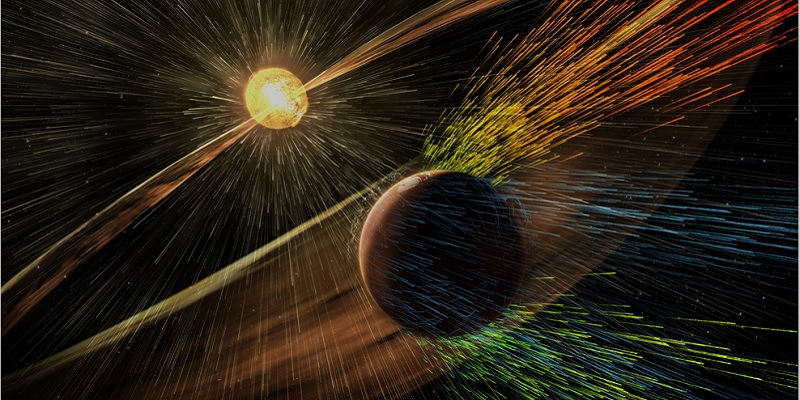
Artist’s rendering of a solar storm hitting Mars and stripping ions from the planet’s upper atmosphere. Artist’s rendering of a solar storm hitting Mars and stripping ions from the planet’s upper atmosphere. (Image: NASA/GSFC)
The reason for Mar’s negative transformation from a warm, wet planet capable of supporting life to its present cold, harsh environment incapable of holding water is now better understood.
During a Thursday afternoon press conference, NASA announced that information obtained by its ongoing Mars Atmosphere and Volatile Evolution (MAVEN) mission shows the current speed of solar winds, charged particles emitted by the sun, which stripped the planet of much of its atmosphere during the early days of the Solar System.
“Mars is more susceptible to the solar winds than a planet like Earth because it lacks a global magnetic field and the protection it provides,” said Bruce Jakosky, MAVEN’s principal investigator at the Laboratory and Space Physics (LASP) at the University of Colorado, Boulder. The red planet once possessed this type of field but eventually lost it. Lacking the shield, Mars is hit by the solar winds, which travel at about 1 million miles per hour, full bore.
“It would have been the turn off of the magnetic field that would have started the turn on of the stripping of the atmosphere,” he said.
MAVEN found solar winds currently hit Mars at about 1 million miles per hour. This is the first time that NASA has been aware of the rate in which the atmosphere leaves Mars.
Due to the contact with the winds, the planet is losing around a quarter pound of gases, like oxygen and carbon dioxide, every second, according to Jasper Halekas, MAVEN solar wind ion analyzer instrument lead at the University of Iowa. During the investigation, MAVEN studied the mammoth solar storms that hit Mars, and found that those storms increase the rate in which the atmosphere leaves the planet. According to Jakorsky, those storms were even greater during the early times of the atmosphere when the sun was more active, and the current rate that the planet losses its atmosphere “isn’t that large.”
Dave Brain, MAVEN’s co-investigator at LASP assured listeners that while the Earth is losing atmospheric particles, it doesn’t lose as many as Mars because it has more protection against the escape. “…It may be some day, far from now, that Earth’s atmosphere would shut down,” he added.
In addition to fielding questions from journalists, the conference participants fielded a bevy of inquiries from space fans via Twitter. One participant asked whether Mars’ atmosphere could ever be regenerated, or in other words, return to its previous state. Fielding the question, Jakorsky said it is impossible for Mars’ atmosphere to return to that previous state because those elements are forever lost in the universe once they are stripped away.
Jakorsky said the data obtained from MAVEN let NASA know how Mars’ upper atmosphere operated in the past, and also proved that Mars previously met all of the qualification necessary to support life. He added that this knowledge, coupled with the fact that much of that atmosphere was stripped away, begs the question of whether or not Mars did indeed harbor life at one point.
Jokorsky also swatted down any possible discussions equating the climate change that has taken place on Mars with that which has taken place on Earth, saying that such a link is like comparing apples and oranges.
Michael Meyer, the lead scientist for NASA’s Mars Exploration Program in Washington, D.C., added that the climate change that has taken place on Earth is so much different than what has transpired on Mars because the former’s changes were caused by humans.
The findings resulting from the MAVEN mission will not only enhance society’s understanding of Mars, but also other planets within the atmosphere. Of course, any information regarding the red planet will aid mankind’s eventual trip to its grounds.
“Understanding what happened to the Mars atmosphere will inform our knowledge of the dynamics and evolution of any planetary atmosphere,” said John Grunsfeld, astronaut and associate administrator for the NASA Science Mission Directorate in Washington, in a press statement released in conjunction with the news conference. “Learning what can cause changes to a planet’s environment from one that could host microbes at the surface to one that doesn’t is important to know, and is a key question that is being addressed in NASA’s journey to Mars.”
MAVEN began studying Mars since entering its orbit in Sept. 2014. The goal of the mission has been to determine how much of Mars’ atmosphere and water has been lost to space. The primary science portion of the mission will be completed on Nov. 16.
Filed Under: Aerospace + defense




